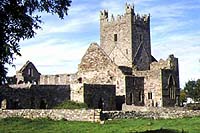Vacation Guide
Ireland golf vacation guide : To do and see
KILKENNY
Black Abbey – forming part of a Franciscan friary founded in 1225, the abbey was dissolved under the hand of King Henry VIII in 1543 and converted for use as a courthouse. The abbey was opened for public worship during the 19th century, while its graveyard provides the final resting place for some ten stone coffins from the 13th and 14th centuries.
Duiske Abbey – situated in Graiguenamanagh and founded by the Earl of Pembroke, this 13th century Cistercian abbey is now a Catholic church. Restored to its original splendour, this is the largest of Ireland’s many Cistercian buildings, while the effigy of a 13th century knight, which was resurrected from the ruins, has been placed near the entrance door.
Inistiogue – southeast of Thomastown is the picturesque village of Inistiogue. Its charming 18th century bridge of ten arches spanning the River Nore and the ruins of an Augustinian priory dating back to 1210 are characteristic of this photogenic village. Inistiogue’s quaint beauty has resulted in both "Widow’s Peak" and "Circle of Friends" being filmed here.
 Jerpoint Abbey – one mile from Thomastown lies the Cistercian abbey of Jerpoint, one of the most impressive monastic ruins in Ireland. Founded in 1160, the abbey flourished until it was suppressed during the 16th century. A fine central tower was added in the 15th century, while the restored cloister pillars are decorated with fine sculpted figures of knights and ladies, bishops, dragons and an unhappy-looking monk, clutching his stomach.
Jerpoint Abbey – one mile from Thomastown lies the Cistercian abbey of Jerpoint, one of the most impressive monastic ruins in Ireland. Founded in 1160, the abbey flourished until it was suppressed during the 16th century. A fine central tower was added in the 15th century, while the restored cloister pillars are decorated with fine sculpted figures of knights and ladies, bishops, dragons and an unhappy-looking monk, clutching his stomach.
 Kilkenny Castle – the great 13th century fortress of the Butler family is one of Ireland’s best-known landmarks and occupies a fine position in Kilkenny City, overlooking the River Nore. The castle, which replaced an earlier fortress erected by Strongbow, remained home to the Butler family until 1936. Visitors may take guided tours of the castle and wander around its extensive landscaped grounds.
Kilkenny Castle – the great 13th century fortress of the Butler family is one of Ireland’s best-known landmarks and occupies a fine position in Kilkenny City, overlooking the River Nore. The castle, which replaced an earlier fortress erected by Strongbow, remained home to the Butler family until 1936. Visitors may take guided tours of the castle and wander around its extensive landscaped grounds.
Rothe House – one of Kilkenny’s oldest mansions, Rothe House was built in 1594 and played a central role as a meeting place for religious and political leaders at the time of the Confederation of Kilkenny. Located in the heart of the city, today the house functions as a museum and doubles as a depository for the collections of the Kilkenny Archaeological Society.
St. Canices Cathedral – overlooking the northern end of Kilkenny City, the present cathedral is built on the site of an early monastic settlement, of which only a 100-foot round tower survives. The cathedral was completed circa 1270, and its limestone effigies of Piers and Margaret Butler, lying side by side here, have the perennial appeal of Egyptian mummies.



